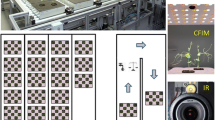Abstract
Phenotyping approaches, using high throughput imaging techniques, are being adopted over the traditional methodologies which are manpower intensive, time consuming and low throughput. However, the effectiveness of high throughput plant phenotyping through imaging in plant phenomics facility essentially requires establishing relationship between plant areas quantified through imaging and the actual biomass. The present study was conducted with an aim to standardise the methodology for digital quantification of tomato biomass using plant phenomics facility. A strong linear relationship was observed between the actual tomato plant fresh mass, digital biomass and projected shoot area. The correlations between plant fresh mass, plant digital biomass and projected shoot area were highly significant at 30, 45 and 60 days after transplanting, but at 75 days no correlation was observed. Hence, the present study clearly demonstrated that the growth of tomato plants could be monitored through digital imaging using either projected shoot area or digital biomass till 60 days after transplanting across genotypes for high throughput phenotyping.






Similar content being viewed by others
References
Bumgarner, N. R., Miller, W. S., & Kleinhenz, M. D. (2012). Digital image analysis to supplement direct measures of lettuce biomass. HortTechnology, 24(4), 547–555.
Edwards, D., Batley, J., & Snowdon, R. J. (2013). Accessing complex crop genomes with next-generation sequencing. Theoretical and Applied Genetics, 126, 1–11.
Furbank, R. T., & Tester, M. (2011). Phenomics—Technologies to relieve the phenotyping bottleneck. Trends in Plant Science, 16, 635–644.
Gerszberg, A., & Huatuszko-Konka, K. (2017). Tomato tolerance to abiotic stress: A review of most often engineered target sequences. Plant Growth Regulation, 83, 175–198.
Golzarian, M. R., Frick, R. A., Rajendran, K., Berger, B., Roy, S., Tester, M., & Lun, D.S. (2011). Accurate inference of shoot biomass from high-throughput images of cereal plants. Plant Methods, 7, 2.
Hairmansis, A., Berger, B., Tester, M., & Roy, S. J. (2014). Image based phenotyping for non-destructive screening of different salinity tolerance traits in rice. Rice, 7, 16.
Harris, B., Sadras, V., & Tester, M. (2010). A water-centered framework to assess the effects of salinity on the growth and yield of wheat and barley. Plant and Soil, 336, 377–389.
Honsdorf, N., March, T. J., Berger, B., Tester, M., & Pillen, K. (2014). High-throughput phenotyping to detect drought tolerance QTL in wild barley introgression lines. PLoS ONE, 9(5), e97047.
Klukas, C., Chen, D., & Pape, J. M. (2014). Integrated analysis platform: An open-source information system for high-throughput plant phenotyping. Plant Physiology, 165, 506–518.
Petrozza, A., Ssysnirllo, A., & Summerer, S. (2014). Physiological responses to Megafol treatments in tomato plants under drought stress: A phenomic and molecular approach. Scientia Horticulturae, 174, 185–192.
Rajendran, K., Tester, M., & Roy, S. J. (2009). Quantifying the three main components of salinity tolerance in cereals. Plant Cell and Environment, 32, 237–249.
Rao, N. K. S., & Laxman, R. H. (2013). Phenotyping horticultural crops for abiotic stress tolerance. In H. P. Singh, N. K. S. Rao, & K. S. Shivashankara (Eds.), Climate resilient horticulture: Adaptation and mitigation strategies (pp. 147–157). New Delhi: Springer.
Tackenberg, O. (2007). A new method for non-destructive measurement of biomass, growth rates, vertical biomass distribution and dry matter content based on digital image analysis. Annals of Botany, 99, 777–783.
Acknowledgements
This work is a part of the National Innovations in Climate Resilient Agriculture (NICRA) project funded by Indian Council of Agricultural Research, New Delhi. The authors are grateful to the Director, ICAR-Indian Institute of Horticultural Research, Bengaluru for all the support. We would also like to acknowledge Mr. Sridhar, C. for the technical assistance.
Author information
Authors and Affiliations
Corresponding author
Electronic supplementary material
Below is the link to the electronic supplementary material.
Rights and permissions
About this article
Cite this article
Laxman, R.H., Hemamalini, P., Bhatt, R.M. et al. Non-invasive quantification of tomato (Solanum lycopersicum L.) plant biomass through digital imaging using phenomics platform. Ind J Plant Physiol. 23, 369–375 (2018). https://doi.org/10.1007/s40502-018-0374-8
Received:
Accepted:
Published:
Issue Date:
DOI: https://doi.org/10.1007/s40502-018-0374-8




